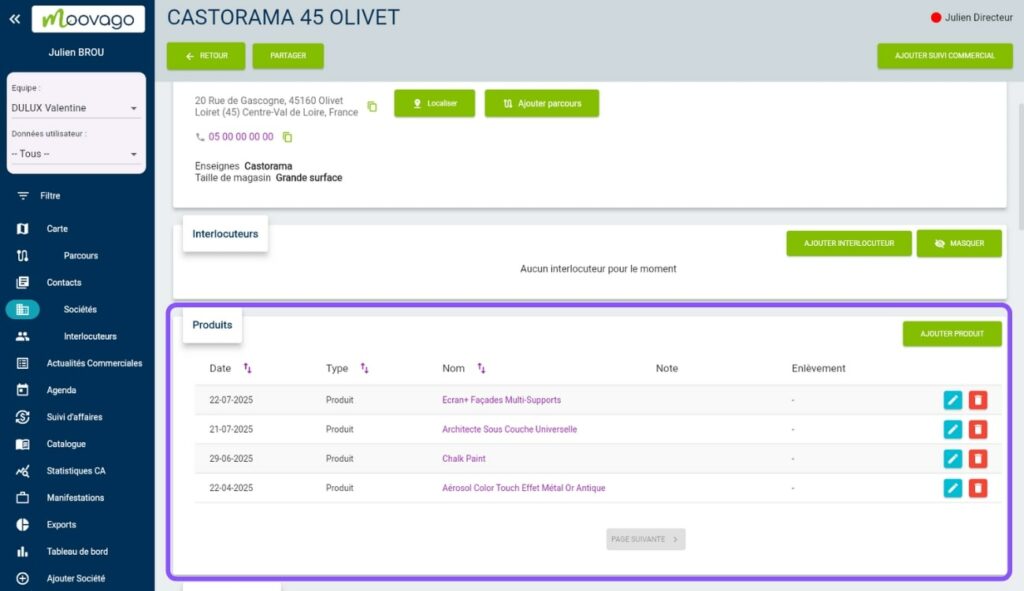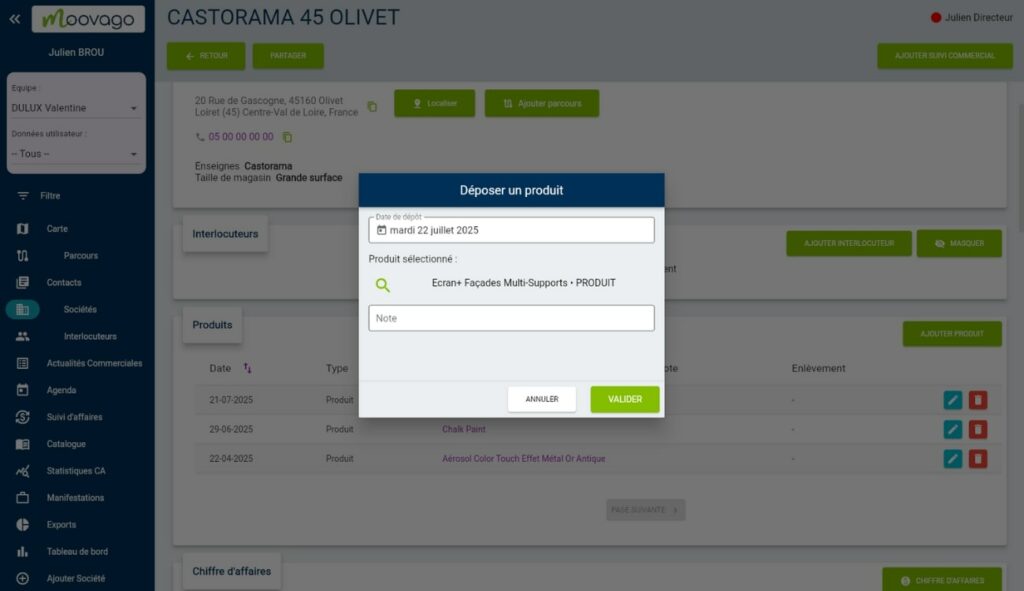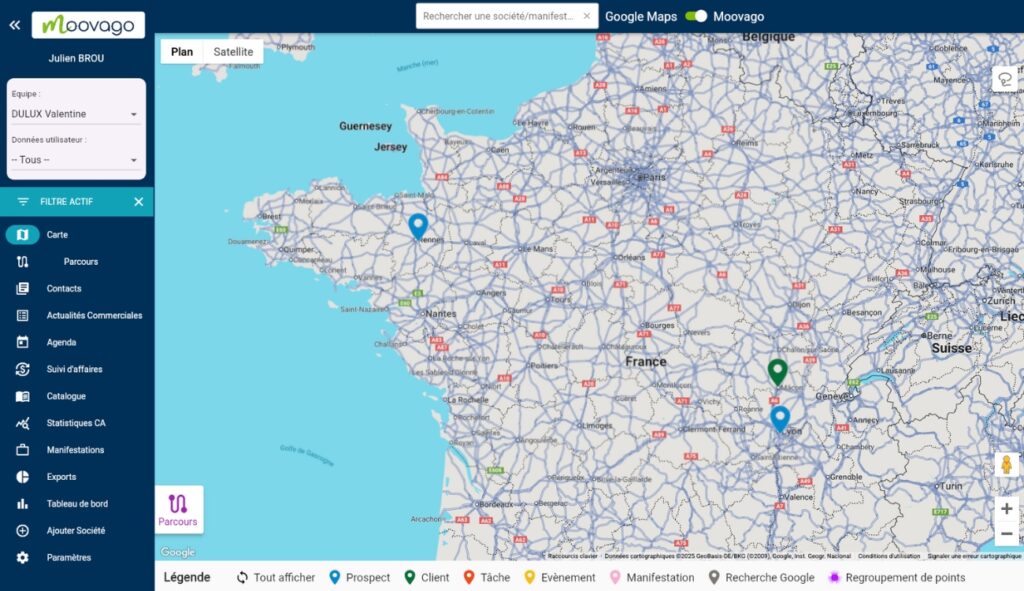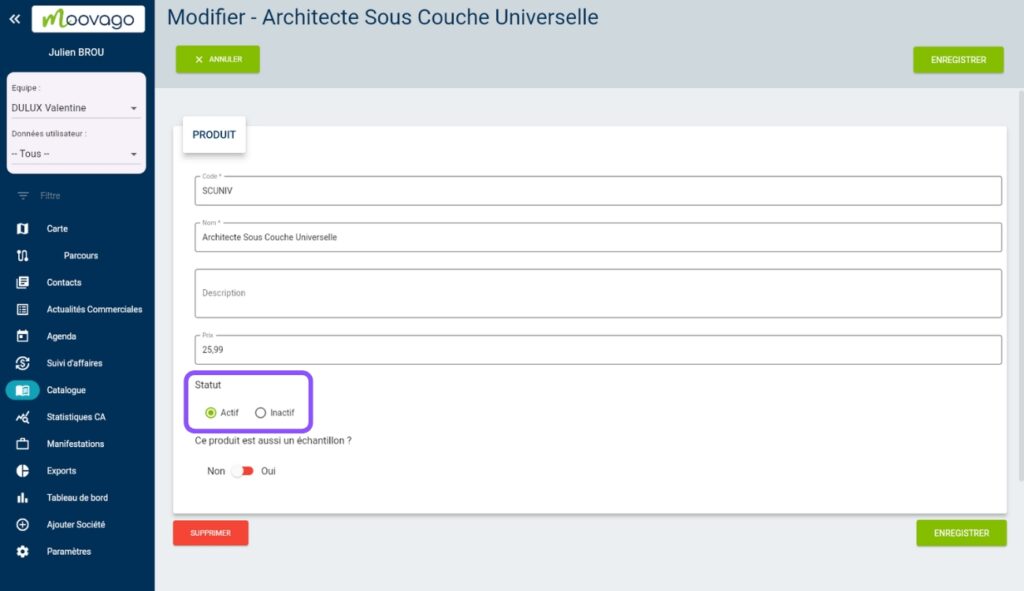Welcome to this video tutorial on Catalogue management in Moovago!
Together we’ll see how to manage your products, samples and POS effectively by learning how to :
- Understand the benefits of Catalogue follow-up for your sales actions
- Add catalogue items to a company
- Manage your POS (drop-off and pick-up)
- Delete or deactivate catalogue items
Before distributing your products
Before you start, make sure you have :
- Create your elements from Moovago’s “Catalogue” tab,
- Access to a company file where you can add your elements.
Resource: discover our complete guide to adding items to the Catalogue.
Add catalogue items to a company
Once you’ve created your products and companies, you’ll be able to link them together.
Step 1: Go to the "Product" section in the desired company file
- Go to a company file
- Navigate to the “Product” section

Step 2: Check current status
In this section, you can see :
- If one or more products have already been sold/distributed to this company,
- If a sample has been distributed,
- If a POS is currently present.
Step 3: Add an element
Of course, you can also add new elements to your companies. To do this:
- Click on “Add at the top right of the “Products” block,

- In the window that opens :
- You can specify a deposit date,
- Next, select the catalogue item from the Catalogue to add to this company in “Search for a product” (products matching your sales plan are displayed first),
- Add a note if necessary (optional).
- Click on “Validate” button.
Result: Your item now appears in the company file!

Manage your POS
When the time comes to retrieve a POS item, follow these instructions:
- Go to the company file from which you are removing your POS, or to the Catalogue tab > POS,
- Locate the POS in question and click on the purple button in the “Collection” section,
- Select the recovery date,
- Click on “OK”.

Result:
- In the company file, the purple circle changes to show the recovery date.
- In the Catalogue, the product now indicates that it is not in any company. Its history has been updated to show when it was picked up.
This date can be changed by clicking on it again.
4. Use Catalogue data for your sales campaigns
Once your Catalogue items have been entered in the company files, this information becomes a real sales lever. Moovago transforms this field data into strategic insights to optimize your prospecting and customer follow-up.
To use this feature, go to the Catalogue, then click on the desired product, sample or POS. Then, in “Company presence”, you can consult the complete list of companies having the product (“Present”), or not having it (“Absent”). You can apply these filters to your entire Moovago session by clicking on the “Activate filter” button.
This filter is now activated throughout your Moovago session, and the map and company list display will be sorted accordingly.
📊 Analyze product presence to target your actions
Product breakdown analysis instantly reveals where to focus your sales efforts. By filtering your companies according to the presence or absence of specific products, you can quickly identify your priorities for action.
Companies without product A represent sales opportunities to be seized during your next visits. On the other hand, companies that have received a sample but never placed an order deserve a targeted follow-up to understand what is holding them back.
Last but not least, identifying companies with old POS enables you to propose a renewal and maintain a dynamic image of your brand in the field.
🗺️ Visualize on the map to optimize your travels
Moovago’s interactive map becomes even more powerful when it displays the geographical distribution of your products. You can see at a glance all the companies equipped with a specific product, and identify under-equipped geographical areas.
To use this feature, go to the map and click on the “Filter” tab in the vertical menu. Look for the “Product” section, then choose whether you want to display companies with or without a product, sample or POS.
This cartographic vision helps you plan highly efficient themed rounds: a day dedicated to the roll-out of a new product, a POS collection round, or a series of visits to relaunch distributed samples.


5. Delete an item from a company
In the event of an error, you can delete a Catalogue item added to a company file at any time.
- In the company file in question, navigate to the “Product” section,
- Then click on thetrash icon next to the item,
- Confirm deletion in the message that appears.
⚠️ Warning: This deletion is final!

6. Deactivate a catalogue item
When to use this function
Deactivating a Catalogue item is particularly useful in a number of common business situations. Unlike deletion, a deactivated item retains its history, but can no longer be moved or added to new companies.
When a product reaches the end of its commercial life, you no longer want to offer it to new customers, but you do want to keep track of all the customers who have purchased it in the past. This information is invaluable for any follow-up campaigns on replacement products, or for analyzing your historical performance.
In the case of obsolete elements such as old samples or POS from completed campaigns, deactivation enables you to keep a complete history of your field actions, while avoiding confusion when you next enter data.
To optimize your future searches, deactivating irrelevant items saves you precious time. You’ll no longer see these references appear in your selection lists, simplifying and speeding up your daily tasks.
Deactivation procedure
- Go to the “Catalogue” tab,
- Select the item to be deactivated,
- Click on the slider to change it from “Active” to “Inactive”,
- Save your changes.

How can Moovago's approach help you?
The Catalogue lets you record the entire life cycle of your products, turning them into invaluable field dates to guide your real sales and distribution strategy.
Optimize your prospecting
- Identify the companies where a product is present or absent,
- Prioritize your visits according to the presence/absence of your products,
- Detect decisive product sales and follow-up opportunities.
Manage your business
- View all companies that have purchased a specific product,
- Track the distribution of your samples,
- Locate your POS in real time.
Optimize your reminders
- Plan the recovery of your POS,
- Schedule your sample follow-up tasks,
- Measure the impact of your actions in the field.
💡 Case in point: You sell sunglasses. Thanks to the Catalogue, you instantly know which opticians don’t yet have your display, and you can plan a targeted round!
